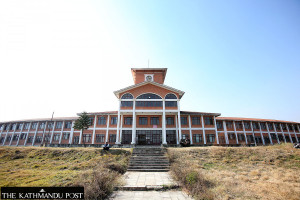Editorial
Timber trouble
While timber harvested in Nepal is rotting away, the country is also importing all kinds of wood products.
Nepal’s lowland is home to many forests, including the invaluable Sal (Shorea robusta). Yet, due to mismanagement, much of the timber harvested from these trees remains unused. For instance, in the eight districts of the Madhesh province, approximately 210,000 cubic feet of wood lie unused in various Division Forest Offices. Some have been lying in community forests for over two decades. Some timber collected from the trees felled in 2019 to construct the 400 kV Hetauda-Dhalkebar-Duhabi transmission line are now starting to rot. Worse, logs are also subject to wildfire, as recently happened at the Gaindatar subdivision forest in Ward 3 of Chandrapur Municipality in Rautahat district. A total of 22 piles of logs and 11 stacks of firewood were ablaze in the wildfire in April. The problem, however, extends beyond Madhesh Province.
In response to increased smuggling of trees, including Sal, successive governments have repeatedly imposed a blanket ban on their harvesting. But such prohibitions have only exacerbated the problem. Logs seized from illegal processes and collected during various forest clearance projects have also faced similar neglect due to their poor management, mainly during the auction process. In some cases, legal hurdles, most importantly unresolved court cases, have frozen their auction. Once a case is filed in court, the seized wood cannot be managed until a decision is made. But in many cases, the courts have yet to decide the fate of such timber. And then there are regulatory bottlenecks. While the Forest Act allows forest officials appointed by the federal government to settle cases, many officers are under provincial governments’ jurisdiction, which has hampered auction orders.
As a result, Nepal is not only squandering a valuable natural resource but also losing out on massive revenue. Had the logs left to rot in the districts of Madhesh been managed on time, it would have helped the government generate up to Rs500 million in revenue. Ironically, while the timber in the country is unused, Nepal has continued to import timber and wood products worth billions—Rs2.33 billion in 2020-21, Rs7.99 billion in 2021-22 and Rs6.4 billion in 2022-23. Dealers buy logs, swan wood, plywood and wooden window and door frames from neighbouring countries—China and India—as well as Indonesia, Malaysia, Myanmar, Singapore and Ukraine. Such heavy imports have also undermined Nepal’s goal of becoming self-sufficient in wood, as envisioned in the Forestry Sector Strategy (2016-25). Moreover, the paucity of timber in the Nepali market has prompted people to buy wood from illegal sources at inflated prices. Some years ago, traders sold Sal logs at Rs3,200 to Rs3,500 per cubic foot, but now the sales are decreasing.
While some forest chiefs have started seeking court orders to ease the auction process, experts emphasise more sustainable solutions. Before more logs are lost to authorities’ mismanagement and other unscrupulous activities, the government must find ways to lift the judicial hurdles and streamline the auction process. The value of our trees and timber cannot be overstated. Sal is the most prized tree species native to Nepal and the Indian subcontinent. The authorities would be wise to focus on making optimal use of our resources rather than continuing to follow the myopic strategy of allowing them to go to waste and then importing the shortfall from other countries.




 16.12°C Kathmandu
16.12°C Kathmandu














